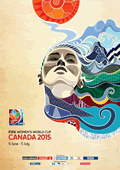FIFA Women's World Cup 2015
 The seventh Women's World Cup was awarded to Canada in 2011 after the only other candidate, Zimbabwe, withdrew. It was the first tournament to feature 24 teams and the first to be held in Canada.
The seventh Women's World Cup was awarded to Canada in 2011 after the only other candidate, Zimbabwe, withdrew. It was the first tournament to feature 24 teams and the first to be held in Canada.
This was also the first World Cup to be played entirely on artificial turf, a decision that prompted a legal challenge from 50 players alleging that this amounted to gender discrimination. (Before the 1994 men's tournament, FIFA spent $2m to replace artificial surfaces in New Jersey and Detroit with grass: the litigants argued that this was done to make the playing surface safer.) The action was dropped in January 2015, removing the threat of a boycott.
For the first time the Hawk-Eye system was used to assist decisions on whether or not the ball crossed the goal line.
The teams finishing first and second in each group went forward to the knock out phase along with the four third placed sides with the best records in group matches. The first two rounds of group matches were played as double-headers. Teams played their first two group games in the same city, reducing the need for travel across Canada's vast distances.
Six cities across five time zones hosted matches.
Group A | Group B | Group C | Group D | Group E | Group F | Knock Out Stages